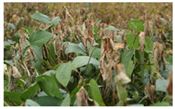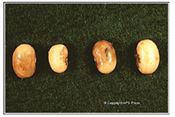Anthracnose Found On Soybeans In Southwest Missouri
LAMAR, MO.
Jill Scheidt, agronomy specialist with University of Missouri Extension, scouted fields near Arcola in Dade County and north of Liberal in Barton County.
SOYBEAN REPORT
Scheidt observed soybeans in the full seed to maturity stage.
“Once soybeans reach physiological maturity, they are safe from freeze,” said Scheidt. The average frost date in Missouri is Nov. 7.
Scheidt observed anthracnose tip blight in fields with developing seeds.
“Anthracnose typically shows up after a rainy period and causes leaves and pods at the top of the plant to turn yellow and die prematurely,” said Scheidt.
Stems and pods may have irregularly shaped lesions, and seeds may have a general blotchy brown discoloration, similar to purple seed stain.
“Seed discoloration is increased by warm, wet weather late in the season,” said Scheidt.
There is no rescue fungicide; fields should be harvested as soon as possible to prevent further damage.
“Anthracnose survives on soybean residue, so rotate crops and do not save infected seed,” said Scheidt.
WHEAT REPORT
“We are now past the Hessian Fly-Free Date,” said Scheidt.
Wheat should be scouted throughout the fall for aphids and again in the spring. Look for bird cherry oat aphids as they vector barley yellow-dwarf virus. Bird cherry oat aphids are olive green with a red band near their rear.
“Threshold levels are 12-15 bird cherry oat aphids per foot of row. Examine the underside of leaves and near the crown for aphids when days are cooler,” said Scheidt. ∆

Tip blight on soybean
Photos credit: MU Extension

Anthracnose seed discoloration